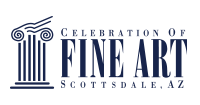What happens when a mechanical engineer in the aerospace industry turns professional watercolor artist? This is not the setup for a clever punchline delivery––it’s the path Heidi Rosner took on her journey to becoming a fine art artist.
And as it turns out, her engineering mind combined with an innate talent resulted in a body of work that balances precision with an undeniable joie de vivre that brings joy and energy to any space it inhabits. This is in large part because of Heidi’s two other loves: rich, vibrant color and nature. Whether desert wildflowers, cacti or birds as the subject matter, Heidi has become known for her deep, saturated colors, which is not a common trait of most watercolor art.
Still, despite her penchant for color, Heidi is not one to become complacent. This year, she pushed herself to experiment with a new composition––leaving the background completely white. This forced her to look at the negative space in a new way and use the white to make interesting shapes to guide the eye through the piece.
Read on or watch the video below to learn more about Heidi Rosner and what inspires her work.
When did you know art was your calling?
I was resistant to it for a while, but I decided to make the leap into doing it full-time around 2003. I was kind of between making the decision to make the leap or stay doing what I was doing previously. It was exciting, but also nerve-wracking.
I had a consulting business and I got a lot of appreciation for what I was doing there, but the appreciation that I got from being an artist was different. It had a different feel to it––a different flavor if you will. Not that I do it for recognition or appreciation, but when somebody tells me that something I’ve done has had an impact on how they feel every day, that’s big. And that was really what enabled me to say, “Yes. I’m doing the right thing. This is a good decision.”
What do you love most about creating art?
Most of what I paint these days are subjects that occur in my world––my outside world––plants, birds, critters, flowers and landscapes. I love to hike. I love to be out in my area. I live in Arizona and so it’s nice to be outside and appreciate all the desert has to offer. And when I can take some of that and incorporate it into a piece of my work, and have it reflect my love for what I see and where I live and how I choose to spend my time when I’m not painting, it’s so gratifying because I love the desert so much. I tell people that I’m a lizard because I was born to be in a hot, dry environment and appreciate everything that there is about this place. It’s just so fabulous. I love it.
How do you keep yourself challenged?
I’m known for my color––my bright, bold, vibrant, rich, deep, saturated color. People have come to know me for that––for my backgrounds, foregrounds and my botanicals. Even my birds have bright, vibrant colors associated with them either in the background or as part of their plumage. This year I decided to try something a little different. I experimented with leaving the field––the background of a painting––white instead of putting in these rich, dynamic colors. I did a few studies, hung them on the wall at the studio and they sold immediately. I liked them a great deal and I was kind of surprised by that. So I decided to experiment with a bigger piece––a 36” X 48” agave.
While I was painting it, I was having little anxiety attacks because the background wasn’t filled in with color. I typically paint the background first on my pieces and that tells me what I want to do color-wise and tone-wise with the foreground. It sets the stage if you will. So, I didn’t set the stage on this one. I painted this subject and I kept getting distracted by the white background going. But I left the background white, finished the piece, varnished it, framed it, and it’s currently one of my favorite pieces that I’ve ever done. It’s so dramatic and so clean and crisp. And it just speaks to the dynamic energy of the light and shadow in the desert. I love it.
What brings you back to the Celebration of Fine Art?
My people––the community of artists that are here. They’re amazingly talented. They’re so diverse. I’ve known many of these artists for decades and I still learn new things about them. The community of artists that are here among the best in the country, and it’s a privilege to be among them––to be a peer.
The clientele that comes through––my collectors. Because I’ve been doing the show for 21 years, I have people that come year after year that have become friends. They’ve become like family members to me. They may have walls that are full and I honestly don’t care. They come to visit, to say hello. Sometimes they just need a hug. They have become an extension of my family because I see them every year. Then there are the new collectors that come in with their energy and enthusiasm and their love of art. The people who come to this show never cease to amaze me––how interested they are in art and how much their desire to learn more exists from year to year.
Then there’s the family. Susan and Jake who run this show––who curate this show and keep it running in great weather, in bad weather, etc.––they are two of the most capable humans I’ve ever met. And I just love them.

